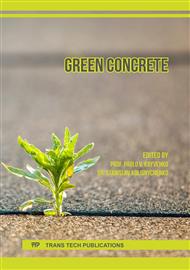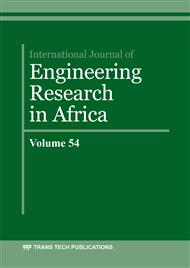[1]
O.M Olofinnade, A.N Ede, J.M Ndambuki, B.U Ngene, I.I Akinwumi, and O. Ofuyatan. Strength and Microstructure of Eco-Concrete Produced using Waste Glass as Partial and Complete Replacement for Sand, Cogent Engineering, 5, (2018), 1483860, 1-19.
DOI: 10.1080/23311916.2018.1483860
Google Scholar
[2]
K.P Mehta, and P.J.M Monteiro Concrete: Microstructure, properties, and materials (3rd ed.). New York: McGraw-Hill, (2006).
Google Scholar
[3]
US Concrete Industry Report; Library of Congress: New York, NY, USA, (2001).
Google Scholar
[4]
A.M Neville. Properties of Concrete, ELSB 5th Edition; Pearson Education Publishing Ltd.: London, UK, (2005).
Google Scholar
[5]
K.H Mo, U.J Alengaram, M.Z Jumaat, S.P Yap, S.C Lee. Green concrete partially comprised of farming waste residues: A review. J. Clean. Prod., 117, (2016), 122–138.
DOI: 10.1016/j.jclepro.2016.01.022
Google Scholar
[6]
M.N Soutsos, K. Tang, S.G Millard. Concrete building blocks made with recycled demolition aggregate. Constr. Build. Mater. 25, (2011), 726–735.
DOI: 10.1016/j.conbuildmat.2010.07.014
Google Scholar
[7]
S. Yehia, K. Helal, A. Abusharkh (2015) Strength and durability evaluation of recycled aggregate concrete. Int J Concr StructMater 9, (2015) 219–239, doi.org/10.1007/s40069-015-0100-0.
DOI: 10.1007/s40069-015-0100-0
Google Scholar
[8]
P.O Awoyera, O.M. Olofinnade, A.A. Busari, I.I. Akinwumi, M. Oyefesobi, M. Ikemefuna Performance of steel slag aggregate concrete with varied water- cement ratio, Jurnal Teknologi, 78, 10 (2016) 125–131.
DOI: 10.11113/jt.v78.8819
Google Scholar
[9]
O.M Olofinnade, A.N Ede and J.M Ndambuki. Experimental investigation on the effect of elevated temperature on compressive strength of concrete containing waste glass powder. International Journal of Engineering and Technology Innovation, 7(2017), 280–291.
Google Scholar
[10]
O.M Olofinnade, A.N Ede, J.M Ndambuki and G.O Bamigboye. Structural properties of concrete containing ground waste clay brick powder as partial substitute for cement. Material Science Forum, 866, (2016) 63–67.
DOI: 10.4028/www.scientific.net/msf.866.63
Google Scholar
[11]
O.M Olofinnade, J.M Ndambuki, A.N Ede and C. Booth, Application of waste glass powder as a partial cement substitute towards more sustainable concrete production. International Journal of Engineering Research in Africa, 31, (2017) 77–93.
DOI: 10.4028/www.scientific.net/jera.31.77
Google Scholar
[12]
Y. Meng, T.G Ling, K.H Mo, Recycling of wastes for value-added applications in concrete blocks: An overview. Resour. Conserv. Recycl. 138, (2018), 298–312.
DOI: 10.1016/j.resconrec.2018.07.029
Google Scholar
[13]
B.S Thomas, R.C Gupta, V. Panikar. Experimental and modelling studies on high strength concrete containing waste tire rubber. Sustain cities soc. 2015. 10.1016/j.scs.2015.07.013.
DOI: 10.1016/j.scs.2015.07.013
Google Scholar
[14]
B.S Thomas, A. Damare, and R.C Gupta strength and durability characteristics of copper tailing concrete, construction and building materials 48, (2013), 894-900.
DOI: 10.1016/j.conbuildmat.2013.07.075
Google Scholar
[15]
R. Siddique, J. Khatib and I. Kaur use of recycled plastic in concrete: A review, waste management 28, (2008), 1835-1852.
DOI: 10.1016/j.wasman.2007.09.011
Google Scholar
[16]
J. Hu, Z. Wang, and Y. Kim. Feasibility study of using fine recycled concrete aggregate in producing self-consolidating concrete, J. sustain. Cement-Based Mater. 2, (2013), 20-34.
DOI: 10.1080/21650373.2012.757832
Google Scholar
[17]
C. Shi, Y Li, J Zhang, W Li, L. Chong and Z Xie Performance enhancement of recycled concrete aggregate-A review. Journal of cleaner production, 112, (2016), 466-472.
DOI: 10.1016/j.jclepro.2015.08.057
Google Scholar
[18]
P.O Awoyera and U.C Okoro. Filler-ability of highly active metakaolin for improving morphology and strength characteristics of recycled aggregate concrete, Silicon, doi.org/10.1007/s12633-018-0017-8.
DOI: 10.1007/s12633-018-0017-8
Google Scholar
[19]
D. Xuan, B. Zhan, and C. S Poon. Durability of recycled aggregate concrete prepared with carbonated recycled concrete aggregates. Cem Concr Compos., 84, (2017), 214–221 doi.org/10.1016/j.cemconcomp.2017.09.015.
DOI: 10.1016/j.cemconcomp.2017.09.015
Google Scholar
[20]
N. Mohammed, K. Sarsam and M. Hussein. The influence of recycled concrete aggregate on the properties of concrete. MATEC Web of Conferences 162, (2018), 02020.
DOI: 10.1051/matecconf/201816202020
Google Scholar
[21]
O.A.U Uche. Influence of reycled concrete Aggregate (RCA) on compressive strength of plain concrete, Continental J. Engineering Sciences 3, (2008), 30 – 36.
Google Scholar
[22]
A Koper, W. Koper and M Koper. Influence of raw material quality on selected properties of recycled concrete aggregates. Procedia Engineering 172, (2017), 536-543 doi.org/10.1016/j.proeng.2017.02.063.
DOI: 10.1016/j.proeng.2017.02.063
Google Scholar
[23]
D. Mohammed, S. Tobeia, F. Mohammed and S. Hasan. Compressive strength improvement for recycled concrete aggregate. MATEC Web of Conferences 162, (2018), 02018 (2018). doi.org/10.1051/matecconf/201816202018.
DOI: 10.1051/matecconf/201816202018
Google Scholar
[24]
E. Arifi, M. Shigeishi, and A. Zacoeb. Effect of fly ash on the strength of concrete made from recycled aggregate by pulsed power. International Journal of GEOMATE, 7(2014), 1009-1016.
DOI: 10.21660/2014.13.87890
Google Scholar
[25]
Wan Nur Syazwani Wan Mohammad, Sallehan Ismail and Wan AbdullahWan Alwi. Properties of Recycled Aggregate Concrete Reinforced with Polypropylene Fibre . MATEC Web of Conferences 66, 00077, (2016).
DOI: 10.1051/matecconf/20166600077
Google Scholar
[26]
M.O. Iman, T. Tafsirojjaman, and M. M Rashid. Treatment of recycled aggregate by impregnation of OPC to improve concrete properties. Proc. of the 2nd International conference on advances in civil Engineering, 26-28, December, 2014, Chittagong, Bangladesh.
Google Scholar
[27]
K.H Younis, and S.M Mustafa. Feasibility of using Nanoparticles of SiO2 to improve the performance of recycled aggregate concrete. Hindawi Advances in Materials Science and Engineering, Article ID 1512830, 11, (2018).
DOI: 10.1155/2018/1512830
Google Scholar
[28]
R. Zhang, X. Cheng, P. Hou, and Z. Ye. (2015). Influences of nano-TiO2 on the properties of cement-based materials: Hydration and drying shrinkage. Construction and Building Materials, 81, (2015), 35-41.
DOI: 10.1016/j.conbuildmat.2015.02.003
Google Scholar
[29]
A. Jamshidi, K. Kurumisawa, T. Nawa, B. Samali and T. Igarashi. Evaluation of energy requirement and greenhouse gas emission of concrete heavy-duty pavements incorporating high volume of industrial by-products. J. Clean. Prod., 166 (2017), 1507-1520.
DOI: 10.1016/j.jclepro.2017.08.141
Google Scholar
[30]
J. Park, Y. Kim, J. Cho, and S. Jeon. Early-age strength of ultra-high performance concrete in various curing conditions. Materials, 8 (2015), 5537–5553.
DOI: 10.3390/ma8085261
Google Scholar
[31]
A.S Abdel-Hay. Properties of recycled concrete aggregate under different curing conditions. HBRC Journal, 13, (2017), 271-276.
DOI: 10.1016/j.hbrcj.2015.07.001
Google Scholar
[32]
BS 812-110. Methods for determination of aggregate crushing value (ACV), London, (1990).
Google Scholar
[33]
BS 812-112. Testing aggregates. Method for determination of aggregate impact value (AIV). Br Stand, London, (1990).
Google Scholar
[34]
BS EN 1097-6. Tests for mechanical and physical properties of aggregates. Br Stand, London, (1995).
Google Scholar
[35]
ASTM C33/C33M Standard specification for concrete aggregates, (2000).
Google Scholar
[36]
BS EN 12350-2. Testing of Fresh concrete; Part 2: Slump test (p.1–12). London, (2009).
Google Scholar
[37]
BS EN 12390-3: 2009. Testing hardened concrete; Part 3: Compressive strength of test specimens (p.1–19). London, (2009).
Google Scholar
[38]
ASTM C618. Standard specification for coal fly ash and raw or calcined natural pozzolan for use in concrete. Am Soc Test Mater. (2008).
DOI: 10.1520/c0618-00
Google Scholar
[39]
H. El-Diadamony, A.A Amer, T.M Sokkary and S. El-Hoseny. Hydration and characteristics of metakaolin pozzolanic cement pastes. HBRC J. (2016), doi.org/10.1016/j.hbrcj.2015.05.005.
DOI: 10.1016/j.hbrcj.2015.05.005
Google Scholar
[40]
K.P Verian, W. Ashraf and Y. Cao. Properties of recycled concrete aggregate and their influence in new concrete production. Resour Conserv Recycl 133, (2018), 30–49. doi.org/10.1016/j.resconrec.2018.02.005.
DOI: 10.1016/j.resconrec.2018.02.005
Google Scholar
[41]
V. Radonjanin, M. Maleˇsev, S. Marinkovi´c and A.E.S Al Malty. Green recycled aggregate concrete. Constr Build Mater 47, (2013), 1503–1511. https://doi.org/10.1016/j.conbuildmat.2013.06.076.
DOI: 10.1016/j.conbuildmat.2013.06.076
Google Scholar
[42]
N. Shafiq, M. F Nuruddin, S.U Khan, and T Ayub. Calcined kaolin as cement replacing material and its use in high strength concrete, Construction and Building Materials, 81, (2015) 313–323.
DOI: 10.1016/j.conbuildmat.2015.02.050
Google Scholar
[43]
M. Malešev, V. Radonjanin, and S. Marinković. Recycled concrete as aggregate for structural concrete production, Sustainability 2, (2010), 1204–1225. http://dx.doi.org/10.3390/su2051204.
DOI: 10.3390/su2051204
Google Scholar
[44]
Y.Y. Tu, Y. Y. Chen, and C. L. Hwang. Properties of HPC with recycled aggregates, Cement and Concrete Research 36, (2006), 943–950. http://dx.doi.org/10.1016/j.cemconres. 2005.11.022.
DOI: 10.1016/j.cemconres.2005.11.022
Google Scholar
[45]
K. W. Anderson, J. S. Uhlmeyer, and M. Russell. Use of recycled concrete aggregate in PCCP: literature search. WSDOT Research Report WA-RD 726.1. 2009. Olympia, WA: Washington State Department of Transportation (WSDOT). 37 p.
Google Scholar
[46]
L. Evangelista, and J. de Brito. Mechanical behaviour of concrete made with fine recycled concrete aggregates. Cement and Concrete Composites 29, (2007), 397–401. http://dx.doi.org/ 10.1016/j.cemconcomp.2006.12.004.
DOI: 10.1016/j.cemconcomp.2006.12.004
Google Scholar



